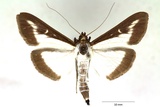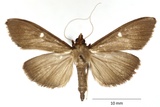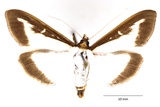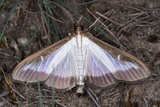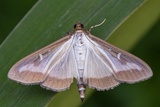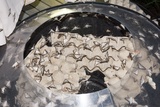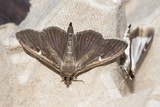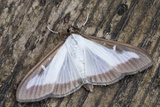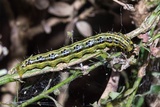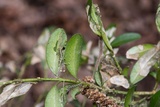Cydalima perspectalis (Walker, 1859) Species
Last modified: April 19, 2024, 10:43 a.m.
First recorded in Belgium in 2010 as larvae, imported with Buxus in a retail trade at Ekeren (AN). About 2 months later the first imago was trapped in LI. This pest species is an introduction to Europe with imported Buxus plants. First observation for Europe was in 2006 in Germany followed by Switserland (2007), Austria, England, Netherlands and France in 2008. Since 2015 it is a very common to abundant species in Belgium, although in the southern part it is still rather rare.
Details
- Classification
- Family: Crambidae > Subfamily: Spilomelinae > Tribus: Margaroniini > Genus: Cydalima > Species: Cydalima perspectalis
- Vernacular names
- Buxusmot (NL), Box-tree Moth, Boxwood Moth (EN)
- First mention in Belgium
- De Prins W. & Steeman C. 2011. Interessante waarnemingen van Lepidoptera in België in 2010 (Lepidoptera). — Phegea 39(4): 121–136. On page 125. view page
- Status
-
Naturalised In Belgium since May 2010.
Cydalima perspectalis originates from the temperate and subtropical regions of East Asia and is an invasive exotic species in Europe. Caterpillars were introduced with some imported Buxus plants. The species spread very rapidly and it destroys the larval hostplant.
Distribution
Imago
Wingspan about 4 cm. The wings are white with an iridescent glow, with a dark brown band on the outer edge and a characteristic white spot on the forewing. There is also a rarer brown variant, which is largely light brown with a white spot on the forewings.
Egg
A female can lay up to 500 eggs, which are approximately 1 mm in size, laid in clusters of 5 to 20 pieces, as a translucent jelly-like mass.
Cocoon/pupa
The pupae are hidden between the leaves and are difficult to find. In the early stage the pupae are green with brown longitudinal stripes, later on towards the end of the pupal stage they turn light brown with a dark pattern.
Bionomics
The females lay their eggs under green, untouched leaves. Depending on conditions such as day length, temperature, and food source, the caterpillars go through five to seven stages of development.
The young larvae feed on parts of the leaf pulp. Adult larvae feed on the entire leaf and can completely defoliate a plant in a short time. A silk remains on the affected plants. The young caterpillars grow into adults within a month. After the caterpillar stage, they pupate in the webs left behind for about two weeks. The last generation of caterpillars overwinters in the host plant.
Because the species hibernates as a larva, larvae are present throughout the growing season of the host plant, meaning that they do not have the opportunity to recover from eating damage. This can cause the plant to die.
The adult moths, which are good flyers hide during the daytime, but they fly at dusk and throughout the whole night. They come to light.
Flight periods
The adults fly in two or three generations a year with the first imago's appearing during April/May towards September. When conditions are right, more generations appear and small numbers can be observed until late in October.
Observed on
- Host plant (species):
- Buxus sempervirens
- Host plant (genera):
- Buxus
The oligophage larva feeds on the leaves and shoots of Buxus.
Habitat
The species occurs everywhere where the food plant is available.
